Disclaimer
I am just a beginner in malware analysis, I’m writing this blogpost to help others and because
it’s good practice:
If I can’t explain something correctly, then I do not really understand it.
If you want to follow along, you can download the sample on MalwareBazaar
Introduction
Hi ! Today I am going to start reverse engineering my first malware ! Let me introduce you to
Hamweq, a malware categorized as an IRC Botnet. You can find more about our friend by
looking up its SHA256 hash 4eb33ce768def8f7db79ef935aabf1c712f78974237e96889e1be3ced0d7e619
Let’s load the binary directly into IDA and get our hands dirty !
First glance from IDA
The binary is a 32-bit windows executable, looking at the different IDA tables, we can see that it has very few functions, imports, and unobfuscated strings:
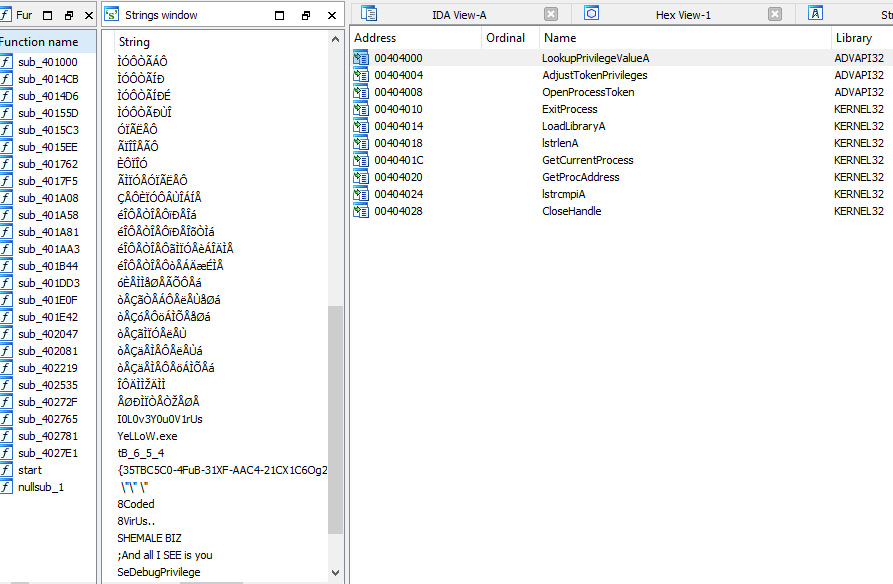
We can immediatly guess that the malware will use dynamic API resolving with LoadLibrary & GetProcAddress after deciphering the names of the DLLs and their procedures !
Main Function
The main function first calls the following subroutine, with lpName pointing to "SeDebugPrivilege"
BOOL __cdecl sub_402781(LPCSTR lpName)
{
HANDLE v1; // eax
BOOL result; // eax
BOOL v3; // esi
struct _TOKEN_PRIVILEGES NewState; // [esp+0h] [ebp-14h] BYREF
HANDLE TokenHandle; // [esp+10h] [ebp-4h] BYREF
v1 = GetCurrentProcess();
result = OpenProcessToken(v1, 0x28u, &TokenHandle); // 0x28 = TOKEN_QUERY | TOKEN_ADJUST_PRIVILEGES
if ( result )
{
v3 = 0;
if ( LookupPrivilegeValueA(0, lpName, (PLUID)NewState.Privileges) )// SeDebugPrivilege
{
NewState.Privileges[0].Attributes |= 2u;
NewState.PrivilegeCount = 1;
v3 = AdjustTokenPrivileges(TokenHandle, 0, &NewState, 0, 0, 0);
}
CloseHandle(TokenHandle);
result = v3;
}
return result;
}
This will try to adjust the SeDebug privilege with SE_PRIVILEGE_ENABLED (0x2u) , effectively trying to elevate privileges
After this function, sub_4027E1 is called with the string "I0L0v3Y0u0V1rUs", followed by a LoadLibraryA call:

The argument to LoadLibraryA being encrypted, we know that sub_4027E1 has to decrypt some strings…
Decryption routine
Looking at sub_4027E1, there is no doubt that it is in fact our decryption routine, and the string "I0L0v3Y0u0V1rUs" is our key
void __cdecl sub_4027E1(LPCSTR lpString)
{
LPCSTR *v1; // eax
LPCSTR *v2; // esi
int v3; // ebx
int i; // ebp
CHAR *v5; // eax
if ( lpLibFileName )
{
v1 = &lpLibFileName;
v2 = &lpLibFileName;
do
{
v3 = 0;
if ( lstrlenA(*v1) > 0 )
{
do
{
for ( i = 0; i < lstrlenA(lpString); ++i )
(*v2)[v3] ^= lpString[i];
v5 = (CHAR *)&(*v2)[v3++];
*v5 = ~*v5;
}
while ( v3 < lstrlenA(*v2) );
}
v1 = ++v2;
}
while ( *v2 );
}
}
lpLibFileName points to a table in the .data section containing the encrypted strings
The algorithm does the following:
- For each encrypted string ->
while (*v2)
- For each character of the encrypted string ->
while ( v3 < lstrlenA(*v2))
- XOR the character with each character of the decryption key
"I0L0v3Y0u0V1rUs" -> for ( i = 0; i < lstrlenA(lpString); ++i ) (*v2)[v3] ^= lpString[i];
- invert every bits from the character ->
*v5 = ~*v5;
Let’s write a Python script to decrypt the string table !
Python Scripting
Let’s first try decoding the very first entry in the table
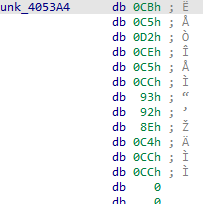
def decode_string(encoded: str) -> str:
decode_key = "I0L0v3Y0u0V1rUs"
decoded = ""
for ce in bytes.fromhex(encoded):
decoded_char = ce
for ck in decode_key:
decoded_char ^= ord(ck)
decoded += chr(~decoded_char & 0xFF) # prevent overflow with bitmask 0xFF
return decoded
encoded = "cbc5d2cec5cc93928ec4cccc"
decoded = decode_string(encoded)
print(encoded_libname + " -> " + decoded_libname)
Run the python script which just implements the decryption algorithm and we get just what we expected !
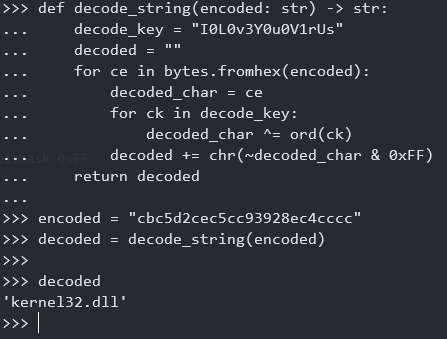
Note that the XOR operation is associative, meaning that B1 ^ B2 ^ B3 == B1 ^ (B2 ^ B3)..So we can reduce step 3 to just XORing the character with the value 95:
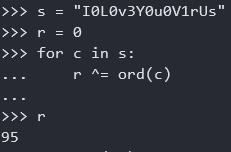
Combinating Python and IDA to defeat string encryption
Let’s use IDA’s Python API to grab bytes easily with the get_bytes(offset, count) function
Our little snippet above now becomes
def decode_byte(byte: int) -> str:
return chr(~(byte ^ 95) & 0xFF)
def decode_string_table():
# range of the encrypted string table in the data section
table_beg = 0x4053A4
table_end = 0x405A74
offset = table_beg
decoded_str = ''
while offset < table_end:
enc_byte = ord(get_bytes(offset, 1))
offset += 1
# we reached end of a string entry, display it
if enc_byte == 0:
if decoded_str:
print(decoded_str)
# reset string being decoded
decoded_str = ''
continue
# check the character is printable
if ord((dec_byte := decode_byte(enc_byte))) < 0x80:
decoded_str += dec_byte
This implementation decodes each byte in the string table, if the byte is not null, it decodes it,
if it is null, it prints the string being decrypted and skips over the null byte.
It also checks that the character is printable so we don’t get flooded with junk data.
Paste this into IDA’s Python interpreter and call decode_string_table
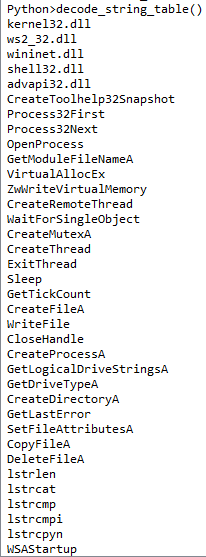
Now you can see the imported DLLs and functions used by the malware !
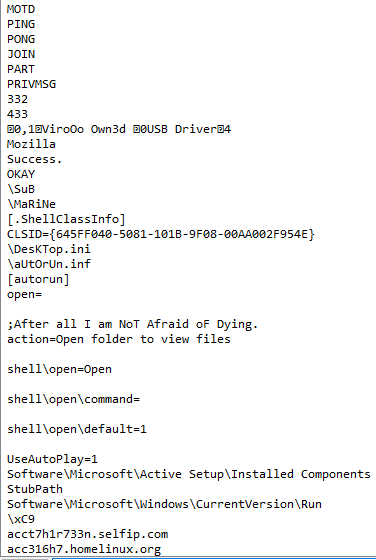
We can also see that strings such as "JOIN", "PING", "PRIVMSG" are commands from the IRC protocol which will quite probably be used by the C2 server.
BTW, we can also see two suspicious domain names: "acct7h1r733n.selfip.com", "acc316h7.homelinux.org" which are possibly the C2 servers ?
Patching encrypted strings into IDA
Now that we can retrieve the original strings, let’s add a few lines to our script to have our original strings in our IDB
def patch_string_table(addr, decoded_str):
print(f"{hex(addr)} -> {decoded_str}")
for i in range(len(decoded_str)):
patch_byte(addr + i, ord(decoded_str[i]))
create_strlit(addr, idc.BADADDR)
def decode_byte(byte: int) -> str:
return chr(~(byte ^ 95) & 0xFF)
def decode_string_table():
table_beg = 0x4053A4
table_end = 0x405A74
offset = table_beg
decoded_str = ''
decoded_count = 0
while offset < table_end:
byte = ord(get_bytes(offset, 1))
offset += 1
if byte == 0:
if decoded_str:
str_addr = offset - len(decoded_str) - 1
patch_string_table(str_addr, decoded_str)
decoded_str = ''
decoded_count += 1
continue
if ord((dec := decode_byte(byte))) < 0x80:
decoded_str += dec
print(f"Decoded {decoded_count} strings from the table")
We just add the patch_string_table function which will replace the encoded string by the decoded string with IDA’s patch_byte(offset, new_byte) function. As before just paste the code into the console and call decode_string_table().
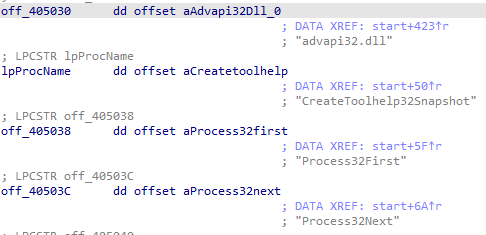
Now we get all the strings automatically decoded in our IDB (note that this of course does not modify the binary itself), but we still need to rename the pointers to
the strings, and we surely do not want to do this manually…An easy way to do this is to select the decrypted table with your mouse:
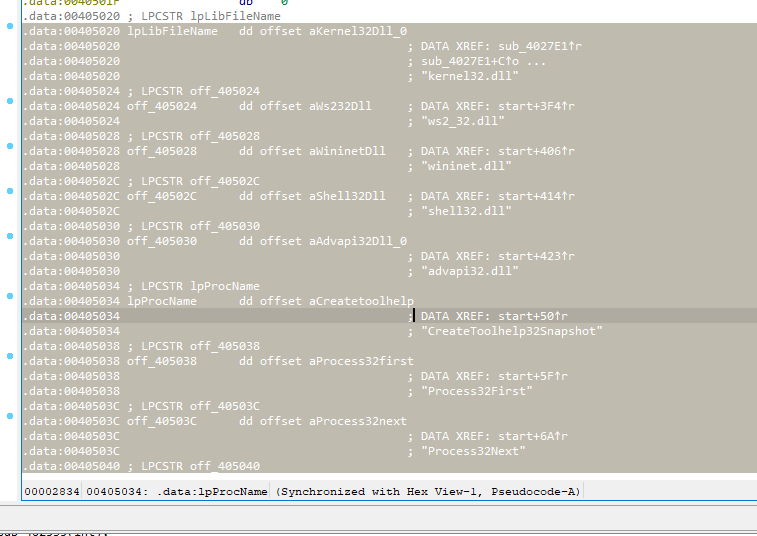
…Then load the built-in script renimp.idc located in <IDA Installation>/idc/.
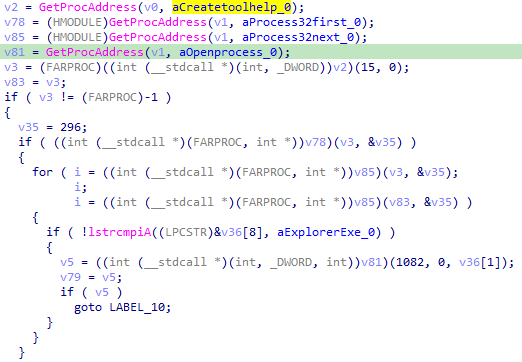
Now we get a way more understandable decompilation and we can already guess what the malware is doing next…But that will be for another blog post :D